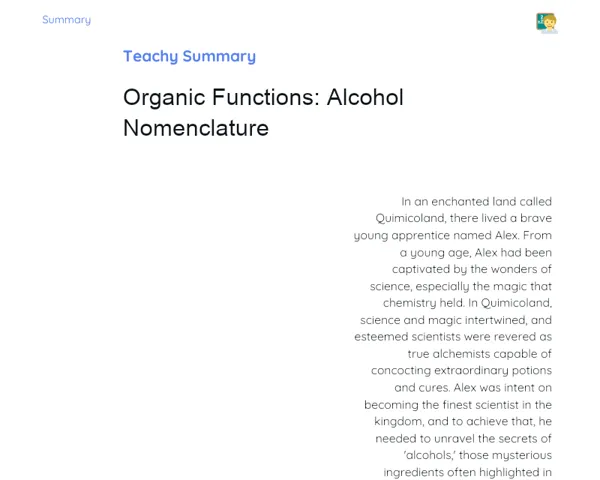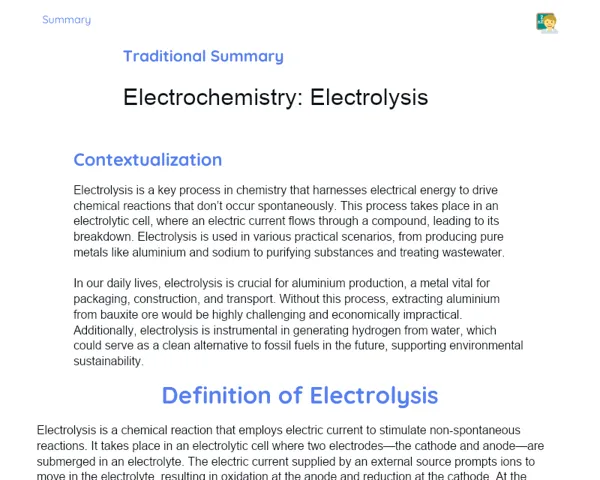Goals
1. Accurately name ethers using IUPAC nomenclature.
2. Identify the molecular structure of ethers and distinguish them from other organic compounds.
3. Appreciate the significance of ethers in the chemical and pharmaceutical sectors.
4. Cultivate practical skills in recognizing ethers in chemical formulas.
Contextualization
Ethers are organic compounds that are extensively used across various industries due to their distinctive properties. They can be found in everyday items like perfumes and anaesthetics and are vital in the synthesis of various chemicals. A solid grasp of the nomenclature and structure of ethers is crucial for any chemistry student gearing up to enter the job market, especially in fields like chemical and pharmaceutical sciences. For instance, ethyl ether was one of the pioneering anaesthetics employed in surgeries, and ethers serve as solvents and intermediates in the manufacture of pharmaceutical products and other key chemical compounds.
Subject Relevance
To Remember!
Definition and Structure of Ethers
Ethers are organic compounds defined by the presence of an oxygen atom bonded to two alkyl or aryl groups. The general formula for ethers is R-O-R', where R and R' can be either the same or different alkyl or aryl groups. This configuration imparts unique properties to ethers, such as low reactivity and high volatility, making them excellent solvents in chemical reactions.
-
Ethers have the general formula R-O-R'.
-
They can consist of the same or different alkyl or aryl groups.
-
They are recognized for their low reactivity and high volatility.
IUPAC Nomenclature of Ethers
The IUPAC nomenclature for ethers is grounded in identifying the alkyl or aryl groups attached to the oxygen atom and combining the names of these groups with the term 'ether'. Typically, ethers are named by listing the alkyl groups in alphabetical order, followed by 'ether'. For example, the compound CH3-O-CH2CH3 is named methoxyethane.
-
In IUPAC nomenclature, alkyl groups are listed in alphabetical order.
-
The names of alkyl groups are succeeded by the word 'ether'.
-
For instance: CH3-O-CH2CH3 is referred to as methoxyethane.
Difference Between Ethers and Other Organic Compounds
The primary distinction between ethers and other organic compounds, like alcohols and esters, lies in the structure and functionality of the oxygen atom. In alcohols, the oxygen is attached to an alkyl group and a hydrogen atom (R-OH), while in esters, the oxygen binds to an acyl group (R-CO-O-R'). In contrast, ethers have oxygen that connects two alkyl or aryl groups (R-O-R').
-
Alcohols have the structure R-OH.
-
Esters possess the structure R-CO-O-R'.
-
Ethers are characterized by the structure R-O-R'.
Practical Applications
-
Ethers are commonly used as industrial solvents thanks to their low reactivity.
-
In the pharmaceutical realm, ethers like ethyl ether are utilized in anaesthetic procedures.
-
Ethers play a role in the synthesis of chemical products, acting as intermediates in various chemical reactions.
Key Terms
-
Ether: An organic compound represented by the formula R-O-R', where R and R' are alkyl or aryl groups.
-
IUPAC Nomenclature: A standardized system for naming chemical compounds, including ethers.
-
Alkyl Group: A functional group derived from an alkane, exclusively made up of carbon and hydrogen atoms.
Questions for Reflections
-
How does precision in the nomenclature of ethers influence safety and effectiveness within the pharmaceutical industry?
-
What importance does comprehending the structure of ethers hold for those engaged in research and development laboratories?
-
What distinguishes ethers from other organic compounds, such as alcohols and esters, concerning structure and applications?
Practical Challenge: Identifying and Naming Ethers
This hands-on challenge aims to cement students' understanding of the nomenclature and structure of ethers, applying recognized knowledge in a practical and interactive environment.
Instructions
-
Form groups of 3 to 4 members.
-
Use molecular modelling kits to create models of various ethers listed in your resources.
-
Name each ether following IUPAC nomenclature.
-
Discuss and jot down potential industrial applications for each ether model.
-
Present the models and discussions to the class.



